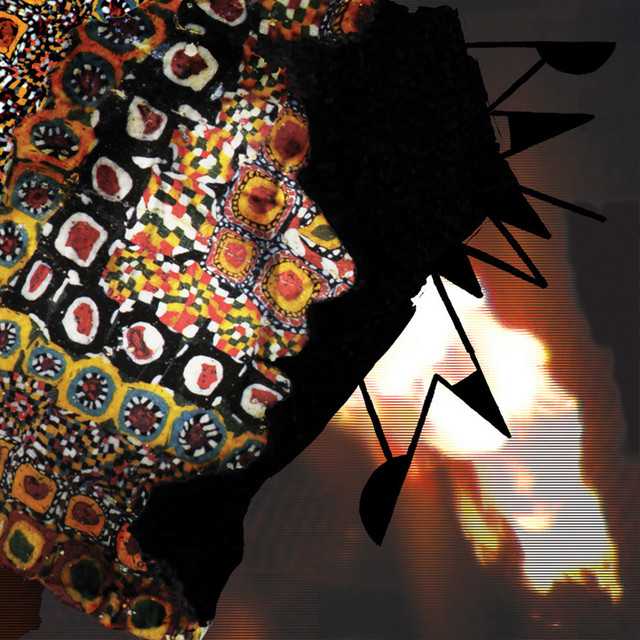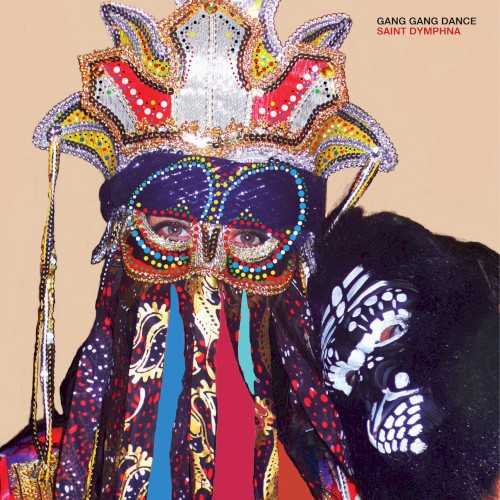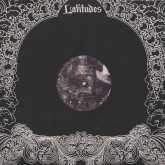Gang Gang Dance | ||
| Allmusic Biography : A band with a boundary-breaking yet instantly recognizable sound, Gang Gang Dance are among the most pioneering acts of the 2000s and 2010s. Their free-flowing style -- which swirls together psych-rock, ambient electronics, hip-hop, and elements of Indian, Middle Eastern, Arabic, Asian, and African music along with Lizzi Bougatsos ethereal vocals -- is rooted in the bandmembers past work in Washington, D.C. and New York Citys experimental music and noise scenes, but becomes harder to classify with each album. With 2008s Saint Dymphna, Gang Gang Dance moved away from their earlier percussion-heavy sound and toward a futuristic pop approach that informed later releases such as 2011s acclaimed Eye Contact and 2018s Kazuashita. Prior to Gang Gang Dances official formation in 2001, the bands members worked together on other projects. Keyboardist/visual artist Brian DeGraw and founding drummer Tim DeWitt met in Washington, D.C. in 1993 and played together in the experimental act the Cranium. While touring with the band, DeGraw and DeWitt met future GGD vocalist Lizzi Bougatsos, frontwoman of the New York band Russia. The Cranium broke up soon after the release of their 1998 album, A New Music for a New Kitchen, and DeGraw and DeWitt moved to New York City. It was there that their paths crossed with guitarist Josh Diamond, a onetime member of Jackie-O Motherfucker and film director Harmony Korines experimental project SSAB Songs. Diamond, DeGraw, and DeWitt then formed the group Death and Dying, which became Gang Gang Dance with the addition of Bougatsos and singer Nathan Maddox. When Maddox died in 2002 after being struck by lightning, Gang Gang Dance continued as a four-piece. In 2004, the band issued its self-titled debut album on Fusetron. After signing to the Social Registry, they released the 2004 compilation Revival of the Shittest and their sophomore album, Gods Money -- which featured the Eastern scales, dub atmospheres, and soaring vocals that became the bands hallmarks -- in 2005. They then issued a string of short releases that included 2005s Hillulah EP and 2007s Rawwar and Retina Riddim EPs. The following year, Gang Gang Dance led the Brooklyn performance of the Boredoms 88BoaDrum, an 88-minute composition for 88 drummers that was staged on August 8, 2008. A month later, the band released its fourth album, Saint Dymphna, which added more structure as well as pop, grime, and dubstep elements. When the band finished touring in support of the album, DeWitt left Gang Gang Dance, with Jesse Lee stepping in behind the drum kit. In 2010, Gang Gang Dance released the limited-edition EP Kamakura via Latitudes and signed with 4AD. Their first album for the label, 2011s Eye Contact, earned acclaim for its mix of pop traditions from Asia, India, and the Middle East and the bands edgy, rough-and-ready electronic signature sound. Following the albums release, the bands members took time to work on individual projects. DeGraw worked on his visual art and released a solo album, 2013s SUM/ONE, as bEEdEEgEE. Bougatsos also worked on her art career, played with her all-female band I.U.D. and contributed to There Will Never Be Silence, a tribute album to John Cages "433," released by MOMA PS1 Records. Meanwhile, Diamond recorded music on his own and also played his first solo shows. The trio made its next album, Kazuashita, with drummer Ryan Sawyer and co-producer and mixer Jorge Elbrecht. A flowing set of songs informed by new age music as well as Gang Gang Dances other wide-ranging influences, Kazuashita appeared in June 2018. | ||
 | Album: 1 of 8 Title: Revival of the Shittest Released: 2003-10-23 Tracks: 8 Duration: 31:15 Scroll: Up Down Top Bottom 25% 50% 75% Allmusic AlbumCover | 1 [untitled] (03:29) 2 [untitled] (02:11) 3 [untitled] (04:49) 4 [untitled] (01:34) 5 [untitled] (05:18) 6 [untitled] (04:33) 7 [untitled] (02:41) 8 [untitled] (06:40) |
| Revival of the Shittest : Allmusic album Review : This early, limited-edition release from the Brooklyn experimental collective is composed of eight untitled tracks. Yet, despite its surface ambiguity, S**TEST is actually one of the band’s more accessible efforts. It’s not an entirely cohesive effort, as certain tracks rely on eerie vocal dissonance and lo-fi dub rhythms, while others feel like Aphex Twin experiments between his ambient and Richard James periods. Tribal percussion and hypnotic drones are constants, but fractured woodwinds and mangled guitar notes creep their way into the pastiche as well, providing an experience that is at times unsettling, but effective, despite its intentional amateurishness. | ||
 | Album: 2 of 8 Title: Gang Gang Dance Released: 2004 Tracks: 2 Duration: 41:15 Scroll: Up Down Top Bottom 25% 50% 75% Spotify Allmusic AlbumCover | 1 Slaven Bladechild (19:18) 2 The Thread (21:57) |
 | Album: 3 of 8 Title: Gods Money Released: 2005 Tracks: 9 Duration: 38:58 Scroll: Up Down Top Bottom 25% 50% 75% Spotify Allmusic Wikipedia AlbumCover | 1 Gods Money I (Percussion) (01:58) 2 Glory in Itself/Egyptian (05:27) 3 Egowar (08:49) 4 Untitled (Piano) (03:19) 5 Gods Money V (03:38) 6 Before My Voice Fails (05:20) 7 Gods Money VII (03:15) 8 Nomad for Love (Cannibal) (04:49) 9 Gods Money IX (02:19) |
| God's Money : Allmusic album Review : Thankfully, the Internet has boundless space, all the better to cope with the twaddle bouncing around the Web about Gang Gang Dance and their latest album. Perhaps people are somewhat baffled that the band is as much a live unit as a studio concern, thus throwing off musical perceptions. Freak-folk, art-noise, tribal dub, you name a whacked-out hybrid description, and its been applied by someone to this group. Take em off-stage, though, and what you really have is an ambient electronic unit thats no more or less experimental than anything coming out on, say, the DiN label. "Gods Money I" and "Gods Money V," for instance, are both built around tribal drum rhythms, the former with wailing vocals on top, the latter in a more experimental, almost Tetsu Inoue mode. "Gods Money IX," in contrast, rolls with thunder and is a much darker piece, while "Gods Money VII" is filled with ambient textures. "Before My Voice Fails" reaches ethereal proportions, while both "Untitled (Piano)" and "Egowar" feature gorgeous synth passages. Even the noisy, fractured "Glory in Itself/Egyptian" has a melody lurking within. The most challenging number, however, is "Nomad for Love (Cannibal)," where shards of musical bits and pieces are only loosely woven together. The Gangs rhythms and textures are intriguing, and much more accomplished in sound than their previous lo-fi efforts. What throws the group for a loop however, are Liz Bougatsos vocals: chanted, singsong babbled, howled, and wailed in turn. Her presence almost solely pulls the Gang out of the ambient world and into another far more disturbing and experimental galaxy entirely. Without her, Gods Money would be a haunting journey through an ever-shifting electronic world, where textures and rhythms are explored to oftentimes great effect. With her, the musical experience is far more difficult, as she cuts across the grain of the atmospheres and moods, suggesting the group will never sit comfortably in any niche but its own. | ||
 | Album: 4 of 8 Title: Rawwar Released: 2007-10-11 Tracks: 3 Duration: 20:36 Scroll: Up Down Top Bottom 25% 50% 75% Spotify AlbumCover | 1 Nicoman (04:16) 2 Oxygen Demo Riddim (05:11) 3 The Earthquake That Frees Prisoners (11:07) |
 | Album: 5 of 8 Title: Saint Dymphna Released: 2008-10-20 Tracks: 11 Duration: 44:08 Scroll: Up Down Top Bottom 25% 50% 75% Spotify Allmusic Wikipedia AlbumCover | 1 Bebey (04:53) 2 First Communion (03:05) 3 Blue Nile (03:09) 4 Vacuum (04:13) 5 Princes (04:26) 6 Inners Pace (04:15) 7 Afoot (03:25) 8 House Jam (04:44) 9 Interlude (No Known Home) (01:16) 10 Desert Storm (05:09) 11 Dust (05:30) |
| Saint Dymphna : Allmusic album Review : Brooklyns Gang Gang Dance is an excellent example of the vibrancy found in the loosely knit underground musical community in New York. Traditionally, the trio has relied heavily on electronics and sampling but has used them to very free-form ends. Influences from Brian Eno to Tetsuo Inoue, and Eastern-tinged world music could be heard in their sprawling textures and ambience-laden warp grooves. With Saint Dymphna (titled for the patron saint of outsiders), GGD has a made another left turn but this time by turning right, away from the abstract collages and murky post-psychedelic tribal music toward more structured forms of electronic dance music: grime in particular. Gone are the long, sprawling ragged jams of previous albums, replaced with 11 "songs," none more than five-and-a-half minutes. The beauty in this is immediately apparent: the listener encounters the influence of latter day digital dubbers like Mad Scientist and Dub Syndicate in the sprawling sonics on the album opener "Bebey," but that quickly morphs itself into a more rugged, robotic formalism with traces of Kraftwerk, Deutsche Amerikanische Freundschaft, and even Der Plan. This opens the fader gates for the floppy electro-funk of "First Communion," the first track to feature Liz Bougatsos vocals. Sharded streams of electric guitar wrap themselves around her voice, also adorned by a deep rumbling bass thats fuzzed to the max, and then the winding, melodic, pulsing, electronic synths and a drum kit. Its the beginning of an exotic journey into sound that gets to the aforementioned dancefloor styles in earnest, such as the slower, four to the floor loops on "Blue Nile," and the truly exotic mélange of samples, sprawling void atmospherics. and stretched beats on "Vacuum." Wildly inventive MC Tinchy Stryder is the featured vocalist on "Princes," where grime and dubstep come together in a rhythm collision of startling proportions. There is some room for the truly abstract here as well, but its in the ambient soundtrack-like "Inners Pace," and more elastic rhythmic construction on "Afoot." But by the time the listener gets to "House Jam" -- which is nothing less than an utterly acid damaged grime track with a "straight" sung vocal by Bougatsos -- shell wonder if shes really hearing GGD at all. "Desert Storm" winds all of these explorations in a tightly constructed mélange of dubstep, electro, breakbeat science, and freaky trip-hop. GGD claim that this record was influenced by the bombast of reggaeton blasting on N.Y. streets. Maybe so, but the brew theyve conjured is their own. Its easily their most fully realized project to date and rather than simply a pastiche, theyve managed to create something nearly concrete. | ||
 | Album: 6 of 8 Title: Kamakura Released: 2010-08-02 Tracks: 1 Duration: 15:10 Scroll: Up Down Top Bottom 25% 50% 75% AlbumCover | 1 Amorphous history (closing seen) (15:10) |
 | Album: 7 of 8 Title: Eye Contact Released: 2011-05-09 Tracks: 10 Duration: 47:49 Scroll: Up Down Top Bottom 25% 50% 75% Spotify TrackSamples Allmusic Wikipedia AlbumCover | 1 Glass Jar (11:21) 2 ∞ (01:03) 3 Adult Goth (06:15) 4 Chinese High (05:12) 5 MindKilla (05:16) 6 ∞∞ (01:33) 7 Romance Layers (04:25) 8 Sacer (05:39) 9 ∞∞∞ (01:25) 10 Thru and Thru (05:40) |
| Eye Contact : Allmusic album Review : Anyone whos spent any time with Gang Gang Dances catalog understands that they never stand still as an entity, evolving in sound and personnel. No two records from their shelf sound alike, though the progression of incorporating music and grooves from other cultures has been steady, if often chaotic, amid the squelch and squeal of their sound collages (through 2005s Gods Money, anyway). With 2008s Saint Dymphna, GGD embraced grime and dubstep in a weave of careening, skittering synths and beats that were almost songlike. All of that said, Eye Contact, GGDs debut offering for 4AD, is startling. Gone are the murky layers of production, angular, abstract dark corners, and black holes of space and rawness. Eye Contact is GGDs first true "pop" record. Liz Bougatsos voice rises to the top of every song here, and these are very formal, if complex songs. This is best evidenced by opener "Glass Jar," which commences with five minutes of blissed-out synth washes, whispering cymbals (courtesy of new drummer Jesse Lee, whose innovative rhythm magic raises the bar). Its bluster enters gradually, winding in from the margins amid the woozy, intoxicating mix, touches of Latin and Caribbean rhythm (via synth) enter briefly before disappearing again, as melody returns before the whole things whispers to a close. Its the finest -- and longest -- track here. "Chinese High" uses Middle Eastern modes and melodies amid criss-crossing bass and drum lines and frequent instrumental interludes where synths zig-zag cross-continental borders from Europe to Asia and beyond. Bougatsos singing invokes both the late Ofra Haza and Noa while sounding like no one but herself. "Mindkilla" is the closest link to Saint Dymphna. Its driven by hard electro-funk, and Bougatsos voice and synths are almost painfully sharp, while remaining irresistibly accessible. "Romance Layers" is gorgeously dubby modern electronic soul with mellifluous bass and guitar carrying up Bougatsos --in her lowest register -- into the erotic depths. Its followed by the glistening, limpid, "Sacer," thats drenched in Eastern pop, and Joe Zawinul-esque synth (à la mid-to late-period Weather Report), an elegantly elastic bassline, and lilting, layered harmonies by Bougatsos that suggest the Cocteau Twins of Heaven or Las Vegas. As full of other sounds, textures, and harmonics as Eye Contact is, GGD are their own animal, and a chameleon-like one at that. Dont expect them to stay here for long. This album is indeed a key turning point for the unit, and easily the most fully realized project in their catalog. | ||
 | Album: 8 of 8 Title: Kazuashita Released: 2018-06-22 Tracks: 10 Duration: 42:20 Scroll: Up Down Top Bottom 25% 50% 75% Spotify AlbumCover | 1 ( infirma terrae ) (01:24) 2 J-TREE (05:51) 3 Lotus (04:54) 4 ( birth canal ) (01:43) 5 Kazuashita (08:07) 6 Young Boy (Marika in Amerika) (04:21) 7 Snake Dub (03:22) 8 Too Much, Too Soon (05:46) 9 ( Novae Terrae ) (01:22) 10 Salve on the Sorrow (05:27) |